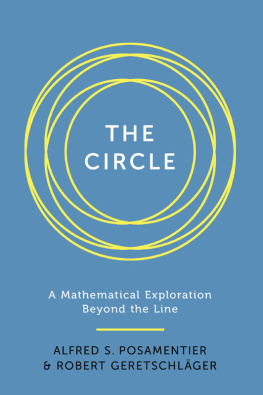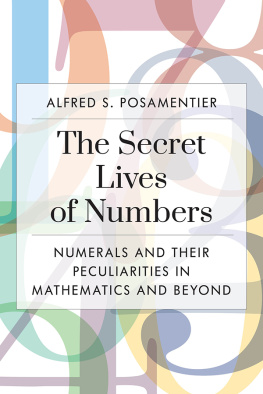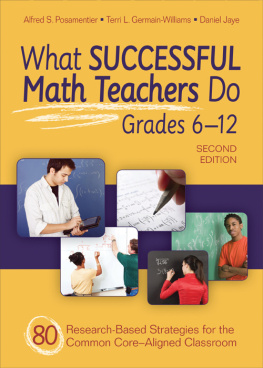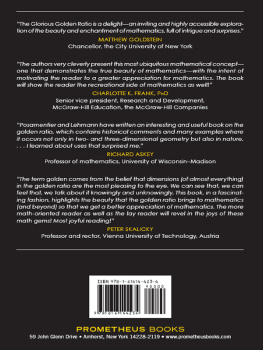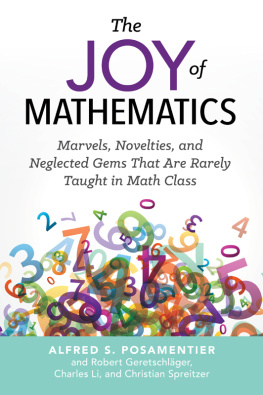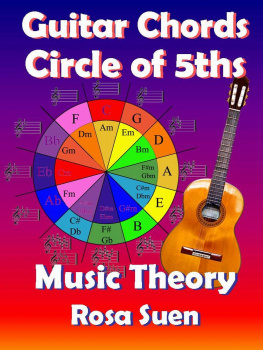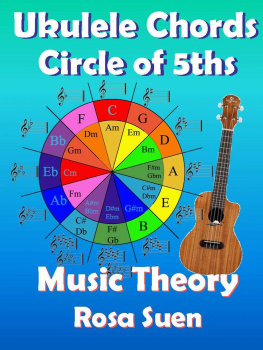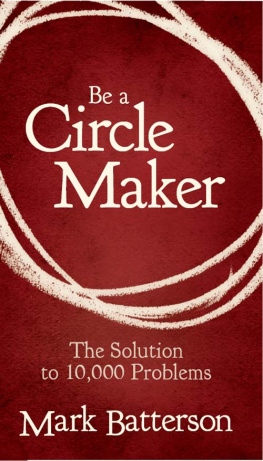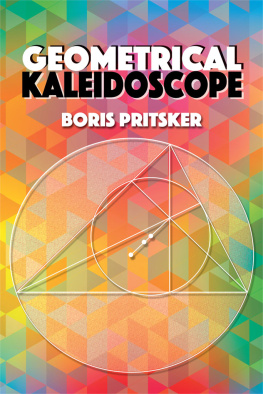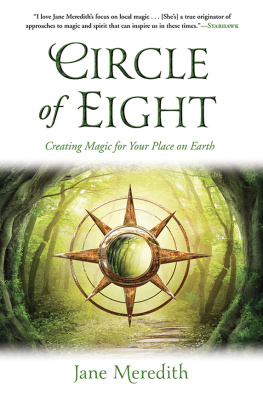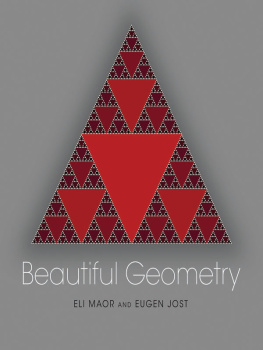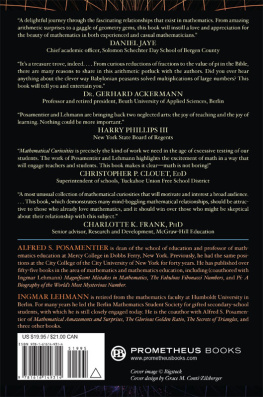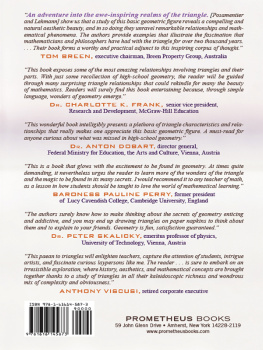ALSO BY ALFRED S. POSAMENTIER AND INGMAR LEHMANN
The Fabulous Fibonacci Numbers
Pi: A Biography of the World's Most Mysterious Number
Mathematical Curiosities
Magnificent Mistakes in Mathematics
The Secrets of Triangles
Mathematical Amazements and Surprises
The Glorious Golden Ratio
ALSO BY ALFRED S. POSAMENTIER AND BERND THALLER
Numbers
ALSO BY ALFRED S. POSAMENTIER
The Pythagorean Theorem
Math Charmers

Published 2016 by Prometheus Books
The Circle: A Mathematical Exploration beyond the Line. Copyright 2016 by Alfred S. Posamentier and Robert Geretschlger. All rights reserved. No part of this publication may be reproduced, stored in a retrieval system, or transmitted in any form or by any means, digital, electronic, mechanical, photocopying, recording, or otherwise, or conveyed via the Internet or a website without prior written permission of the publisher, except in the case of brief quotations embodied in critical articles and reviews.
Trademarked names appear throughout this book. Prometheus Books recognizes all registered trademarks, trademarks, and service marks mentioned in the text.
Cover design by Jacqueline Nasso Cooke
Cover design Prometheus Books
Unless otherwise indicated, all interior images are by the authors or contributors.
Inquiries should be addressed to
Prometheus Books
59 John Glenn Drive
Amherst, New York 14228
VOICE: 7166910133
FAX: 7166910137
WWW.PROMETHEUSBOOKS.COM
20 19 18 17 16 5 4 3 2 1
Library of Congress Cataloging-in-Publication Data
Names: Posamentier, Alfred S. | Geretschlger, Robert.
Title: The circle : a mathematical exploration beyond the line / by Alfred S. Posamentier and Robert Geretschlger.
Description: Amherst, New York : Prometheus Books, 2016. | Includes bibliographical references and index.
Identifiers: LCCN 2016007783 (print) | LCCN 2016011144 (ebook) | ISBN 9781633881679 (hardcover) | ISBN 9781633881686 (ebook)
Subjects: LCSH: Circle. | Circle packing. | Geometry, Plane. | Geometry.
Classification: LCC QA484 .P66 2016 (print) | LCC QA484 (ebook) | DDC 516/.18dc23
LC record available at http://lccn.loc.gov/2016007783
Printed in the United States of America



In the preparation of this book we would like to thank Dr. Hidetoshi Fukagawa for his photos of the Sangaku in , and for this he deserves our thanks. Special thanks are also due to Dr. Erwin Rauscher, for providing the afterword for the book.
A book of this complexity requires very capable editorial management and copyediting. We wish to thank Catherine Roberts-Abel for very capably managing the production of this book, and give special thanks to Jade Zora Scibilia for the truly outstanding editing throughout the various phases of production. The editor in chief of Prometheus Books, Steven L. Mitchell, deserves praise for enabling us to approach the general readership to expose the gems that lie among one of the most commonly seen geometric figures, the circle. Special thanks also go to Hanna Etu, Mark Hall, Bruce Carle, Jacqueline Nasso Cooke, Laura Shelley, and Cheryl Quimba for their hard work.

In elementary plane geometry, there are basically two kinds of lines that are drawn: linear lines (straight lines) and circular arcs (complete circles). The basic element of linear geometric shapes is the triangle. That is to say, most geometric figures composed of straight lines are often broken down into triangular components in order to investigate their properties. In the world of linear geometry, this makes the triangle the key element for inspecting and evaluating geometric relationships. However, the circle is as much a significant portion of plane geometry as is any other component; furthermore, it is the only kind of line that can be drawn on a sphere. This makes the circle perhaps truly more ubiquitous in the world of geometry, in contrast to the straight line, which is not present in spherical geometry. It is with this idea in mind that we embark on a journey to inspect the most common aspects of the role of the circle in geometry.
In the history of mathematics, the circle has fascinated mathematicians perhaps more than any other shape. One aspect of how to trace the history of the circle is through the evolution of the value of pi, . The focus on a preciseor almost precisevalue of has enchanted mathematicians for centuries. Circles have been part of our culture both from a philosophical and from a theological perspective. We will briefly address some of this after we have thoroughly examined the many geometrical wonders that the circle presents.
Before delving into many of the exciting and truly amazing relationships involving circles, we provide a brief review of basic circle relationshipsmany of which are presented in high-school geometry courses.
There are many interesting geometric problems that, because of their simplicity and cleverness, make for a very entertaining introduction to appreciating the power of circles. At a more sophisticated levelor shall we say more prominent levelthere are many relationships in and about circles that have become named theorems because of their significance. In , these are presented in a very comfortable and intelligible fashion. Even some unnamed theorems should cause awe.
Circles that can be inscribed in a triangle, circumscribed about a triangle, or simply tangent to the three sides of a triangle but not containing the interior of the triangle, are often referred to as equicircles, which are explored at length in . Equicircles provide some clever insights into plane geometry and can be very entertaining due to their simplicity.
Constructing circles to meet specific criteria, such as being tangent to other given circles or to given lines, has been one of the challenging problems dating back to antiquity. This problemconsisting of several partsis known as The Problem of Apollonius. In , it is presented and solved in such a fashion that you will feel a true sense of completion, and, we hope, appreciation. It is always interesting to see the kinds of problems that have perplexed mathematicians in antiquity, and we here solve them in a reader-friendly way, so that they can be seen, simply, as solving a puzzle or problem.
We are all taught in high school to do geometric constructions with an unmarked straightedge and a pair of compasses. Some of these constructions are very simple, while others can be more challenging. However, for several hundred years we know that all such constructions could also be done without a straightedge and using just a pair of compasses. These are known as Mascheroni constructions, which are explored in itself. Once again, we will show how the circle can essentially replace the line. Of course, this is more theoretical than practical!
Circles have a very important role in both art and architecture that merits discussion and exposure. This is what we hope to provide in , Circle-Packing Problems).
Next page
